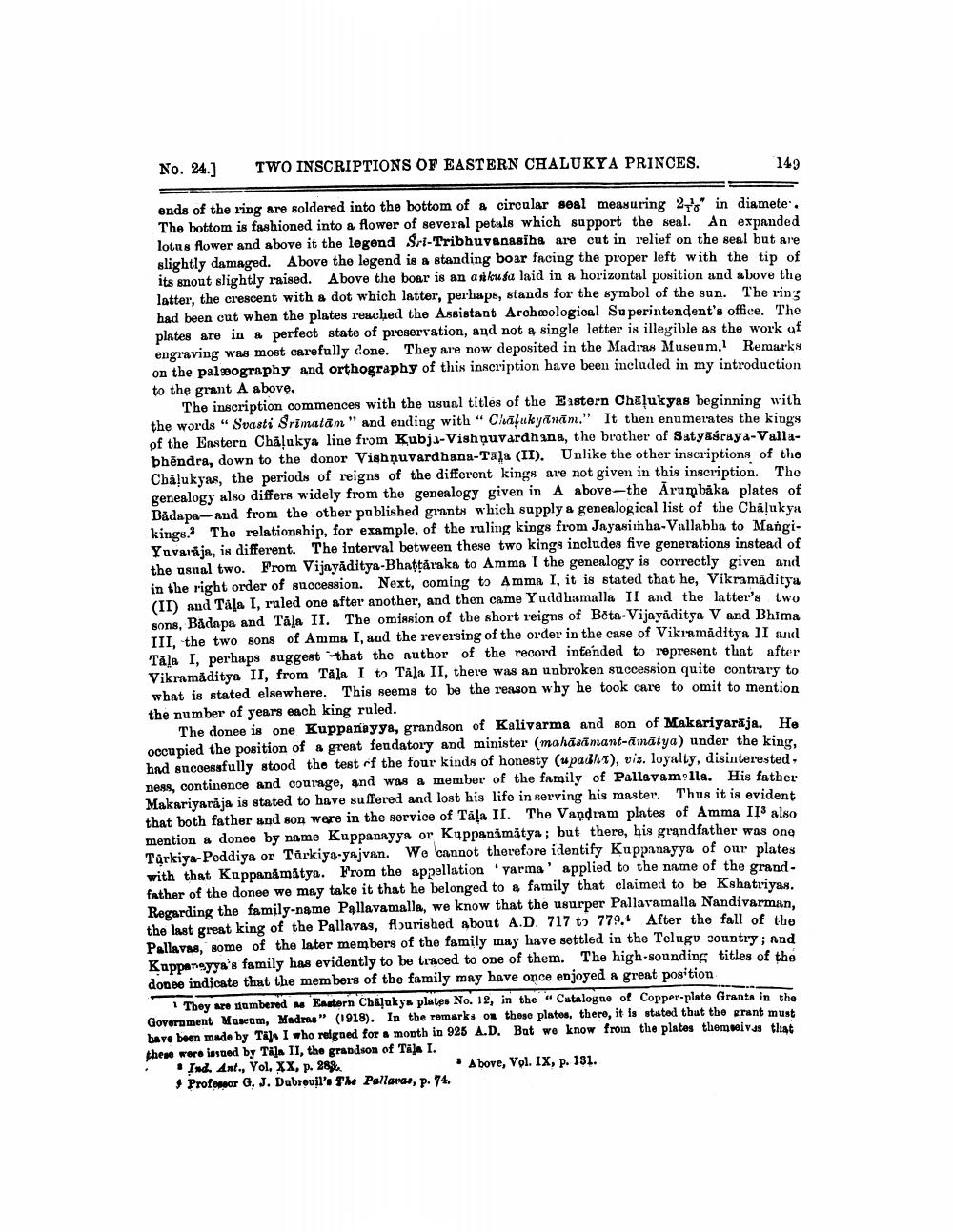________________
No. 24.]
TWO INSCRIPTIONS OF EASTERN CHALUKYA PRINCES.
149
ends of the ring are soldered into the bottom of & circular soal measuring 21 in diamete'. The bottom is fashioned into a flower of several petals which support the seal. An expanded lotus flower and above it the legend Sri-Tribhuvanasiha are cut in relief on the seal but are slightly damaged. Above the legend is a standing boar facing the proper left with the tip of its sont slightly raised. Above the boar is an askusu laid in a horizontal position and above the latter, the crescent with a dot which latter, perhaps, stands for the symbol of the sun. The rin; had been cut when the plates reached the Assistant Archeological Superintendent's office. Tho plates are in & perfect state of preservation, and not a single letter is illegible as the work of engraving was most carefully done. They are now deposited in the Madras Museum. Remarks on the palæography and orthography of this inscription have been included in my introduction to the grant A above,
The inscription commences with the usual titles of the Eastern Chalukyas beginning with the words “ Svasti Srimatān" and ending with " Chilukyānan." It then enumerates the kings of the Eastern Chāļukya line from Kubju-Vishnuvardhana, the brother of Satyāśraya-Vallabhēndra, down to the donor Vishnuvardhana-Tāla (II). Unlike the other inscriptions of the Cbälukyas, the periods of reigns of the different kings are not given in this inscription. The genealogy also differs widely from the genealogy given in A above-the Arumbāka plates of Bådapa-and from the other published grants which supply a genealogical list of the Chalukya kings. The relationship, for example, of the ruling kings from Jayasinha-Vallabha to Mangi. Yuvaraja, is different. The interval between these two kings includes five generations instead of the usual two. From Vijayaditya-Bhattáraka to Amma I the genealogy is correctly given and in the right order of succession. Next, coming to Amma I, it is stated that he, Vikramaditya (II) and Tala I, ruled one after another, and then came Yuddhamalla II and the latter's two sons, Badnpa and Täla II. The omission of the short reigns of Béta-Vijayaditya V and Bhima III, the two sons of Amma I, and the reversing of the order in the case of Vikramaditya II and Tåla I, perhaps suggest that the author of the record intended to represent that after Vikramaditya II, from Tala I to Tala II, there was an unbroken succession quite contrary to what is stated elsewhere. This seems to be the reason why he took care to omit to mention the number of years each king ruled.
The donee is one Kuppanayya, grandson of Kalivarma and son of Makariyar ja. He occupied the position of a great fendatory and minister (mahāsāmant-āmatya) under the king, hnd encoessfully stood the test of the four kinds of honesty (upadl), vis. loyalty, disinterested ness, continence and courage, and was a member of the family of Pallavamolla. His father Makariyarája is stated to have suffered and lost his life in serving his master. Thus it is evident that both father and son were in the service of Tala II. The Vandram plates of Amma II also mention a donee by name Kuppanayya or Kuppanimitya; but there, his grandfather was ong Tûrkiya-Peddiya or Tärkiya-yajvan. We cannot therefore identify Kuppanayya of our plates with that Kuppanåmitya. From the appellation 'yarma' applied to the name of the grandfather of the donee we may take it that he belonged to a family that claimed to be Kshatriyas. Regarding the family-name Pallavamalla, we know that the usurper Pallavamalla Nandivarman, the last great king of the Pallavas, flourished about A.D. 717 to 779.4 After the fall of the Pallavas, some of the later members of the family may have settled in the Telugu sountry; and Kuppangyya's family has evidently to be traced to one of them. The high-sounding titles of the donee indicate that the members of the family may have once enjoyed a great position
1 They are gambered Eastern Chilukys plates No. 12, in the "Catalogne of Copper-plate Grants in the Government Mukom, Modus" (1918). In the remarks on these plates, there, it is stated that the grant must bave been made by Tan I who reigned for a month in 925 A.D. Bat we know from the plates themselves that these were inced by Täla 11, the grandson of Tale I. • Ind. Ant., Vol. XX, p. 28%
• A bove, Vol. IX, p. 131. Profonor G. J. Dabrouil'. The Pallars, p. 74.




